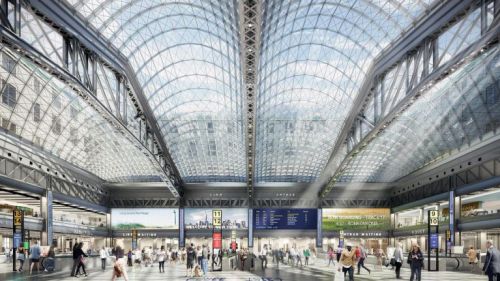After more than three years of construction and $1.6 Billion dollars, the airy new Penn Station main hall opens to the public on Jan. 1, directly across Eighth Ave. from the dungeon-like facility we’ve all hated for decades.
It’s a bright, modern destination for Amtrak, Long Island Rail Road and NJ Transit commuters sick of the crowded and windowless Penn Station hallways and passageways, and also for NYC subway passengers using the busy 34th St./Penn Station stop.
The new Moynihan Train Hall is a 255,000-square-foot facility, inside what used to be New York City’s main post office, formerly called the James A. Farley Building. It is renamed for the late U.S. Sen. Daniel Patrick Moynihan (D-N.Y.), who championed renovating the building to replace for the existing underground Penn Station.
The new Moynihan Train Hall will access 17 of Penn’s 21 tracks, enabling riders to avoid the existing station’s underground maze of dingy passageways when buying tickets and waiting for trains.
“New Yorkers have known for decades that Penn Station needed to be re-imagined,” Gov. Andrew Cuomo said in announcing that the project was completed on time and within its budget. “The pandemic did not stop us from dreaming big and building for the future.”
Cuomo also wants to expand NY and Tri-State train travel.
In his State of the State address last January, he unveiled a proposal to acquire the block south of Penn Station - adjacent to the Hudson Yards commercial and residential complex - and build eight new train tracks underneath. That would expand track capacity by 40%. The proposal is under environmental review.
The new Penn Station matches the new LaGuardia Airport in dreaming big and building for the future.
Repurposing a Landmarked 1912 Building
It was an architectural and engineering feat to repurpose the monumental stone structure, which was constructed in 1912 by the same architects who built the original Penn Station - McKim Mead and White. It was torn down in the 1960s to make way for a new Madison Square Garden, which had outgrown its building on 50th St. and Eighth Ave.
The destruction of the ornate Penn Station horrified historic preservationists.
That included Jacqueline Kennedy, who had been active in preserving Revolutionary Era structures in her native Newport, Rhode Island, and became an active preservationist in New York City, after moving here following the assassination of her husband, President John F. Kennedy, in 1963.
The destruction of Penn Station has been credited with launching the NYC Landmarks Preservation Commission, which has helped save other important buildings from destruction, including Grand Central Terminal and Carnegie Hall.
But I digress.
Some 650,000 people passed through the ugly underground Penn Station station on an average day before the pandemic, making the station the busiest in the Western Hemisphere. But it was not built to handle the crowd. The new facility will do that.
Architects preserved much of the original Beaux Arts-style Farley Building, which is landmarked, while adding new, modern features.
Most prominent is a large central atrium topped by a 92-foot-high skylight roof that is reminiscent of the one in the original Penn Station.
According to Newsday, the Moynihan project is one of many efforts currently in the works to address Penn Station’s design problems and dismal reputation.
The MTA last year approved a $600-million modernization project that will include wider walkways and connect the LIRR’s main customer concourse directly to Seventh Avenue via a new entrance and exit pavilion. MTA spokesman Aaron Donovan said Sunday the project is under construction.


What do you think about this? We welcome your comments.